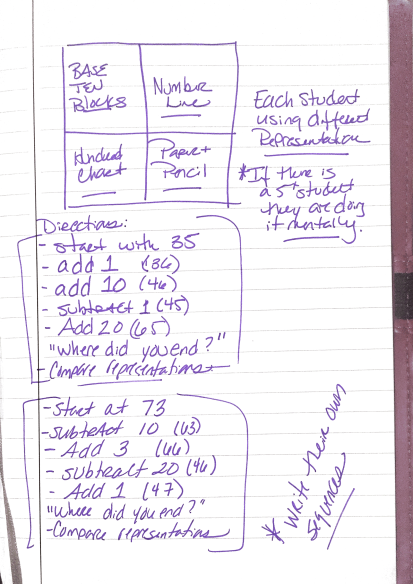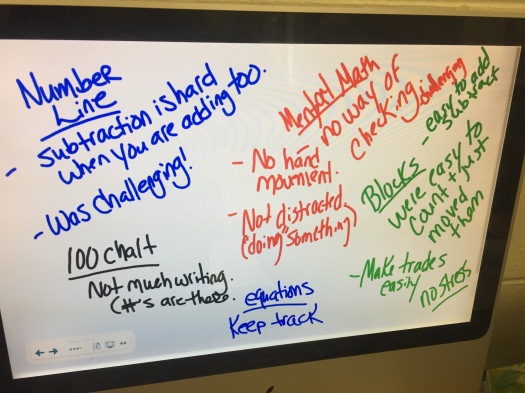There is always a lot of talk about students using an algorithm, process or set of rules, for addition and subtraction. Whether talking about “any algorithm” or “the algorithm,” I am certain, in most cases, people are talking about a process that is absent of tools such as a 100 charts, number lines or base ten blocks. But, what happens when we see the tool becoming an algorithm in and of itself? Can moving left or right on a number line, making jumps of 10s and 1s, writing problems vertically, or jumping rows and columns become an algorithm where students lose sight of the numbers themselves because the process is one more thing to learn?
This was the exact conversation I had yesterday with two 3rd grade teachers as I was leaving school. The students had been playing a game called Capture 5 and struggled making various jumps on the 100 chart. The teacher, understandably, was concerned students were confused about adding and subtracting tens and ones. After more conversation, we began to wonder if the students saw the 100 chart as a set of rules to follow in order to add and subtract instead of a place to look for patterns and structure as we add and subtract. Were they getting caught up in the left, right, up, down movement and losing sight of what was actually happening to the number?
As I thought more about it last night, I wondered about other tools and representations students learn that could easily turn themselves into an unhelpful set of procedures. I also wondered how often we make connections between these tools and representations explicit. Like, when is one helpful over another? How are they the same? How are they different?
I emailed the teacher my notes (below) and we decided we would try this out this morning.

If you can’t interpret from my notes, the plan was to have each student in a group using a different tool or representation as I called out a series of operations to carry out. After the series of addition and subtraction, they compared their answers and discussed any differences. They rotated seats after each series so they had a chance to try out each of the roles.
We came back together to discuss their favorite one. The recording is below…what do I have against writing horizontally, really?? I found this entire conversation SO incredibly interesting!
- They found the base ten blocks to be “low stress” because they were easy to count, move and trade, but did agree that bigger numbers would be really hard with them because there would be too many.
- They really did not like adding and subtracting on the number line with multiple jumps. It got messy.
- They liked mental math because there was nothing (tool) to distract them and they could focus but they didn’t like that you couldn’t check your answer.
- The 100 chart’s only perk was they didn’t have to write the numbers in, they were already there for them.
- I really loved that they mentioned the equations were they only way they could track their work. So if someone in their group messed up, the equation person was the only one that could help them retrace their steps easily.

I am not sure what I learned today, I am still thinking a lot about this. I know that I loved having them compare the tools and representations and that the teacher felt much better about their ability to add 10s and 1s. I feel like there are so many other cools things to do here, but my brain is fried today so that will have to wait!:)


In our pre-algebra class at college, students have a multiplication and addition chart in their notebooks. There are some clever and effective ways to use the charts for things like finding common denominators (you’ve got a list of multiples, right there) and common factors (tougher, but you scan the chart for a row with both numbers).
Some of the students end up learning some of those facts along the way but… most don’t. (They *do* recognize if they’re on the wrong chart…) For some of ’em it’s a “number sense free” approach to “math” 😦
LikeLike
That is what I find too. There is range of how students use it….
1 – They can manipulate the chart and attend to the numbers at the same time which allows them to see the patterns and structure in there.
2 – They can manipulate the chart to get an answer but not attend to the numbers, hence making it an answer-getting tool that doesn’t help them when it is not there or when the numbers get too large.
3- They can attend to numbers but get mixed up in the manipulation of the chart. Which makes me question if they really need to use it and the purpose behind it. I think it is a great tool for seeing structure of adding multiples of 10 and ones, but if they are not being asked to look explicitly at that piece, is it wasted time and more confusing than it is worth for some?
LikeLike
I think there is real value in learning to work with different representations, but there’s a serious risk whenever there’s too much time in “math is about figuring out the answer and finishing” and not enough sense making.
I’m putting together some basic math videos (Camtasia is awesome!) and because I’ve watched too many grownups get the calculator out to add 3 to a big number or add ten… I realized you’re tackling *exactly* what they’re missing. However, would they have been ready in early grades? I don’t know.
LikeLiked by 1 person
Very thoughtful post Kristin! Here’s my take: Adding and subtracting really boil down to more efficient ways to count. And counting is based on the flexible bundling and unbundling of our agreed upon base ten units. Students need many authentic opportunities to count and bundle/unbundle groups of ten in order to understand any of the representations mentioned above. Here’s a post I wrote a few years back as I reflected on this: https://mathspot.net/2013/11/05/packing-cupcakes-and-subtracting-across-zeroes/.
I am very interested in the students who liked mental because there was no tool to distract them. Can you interview some to hear more about their thinking?
Bottom line is that representations are tools that are helpful in building understanding of base ten concepts. But so is any everyday object that can be counted. All should be offered as supports but not required, as you have seen that they can become distractions, or, worse, just another set of rules without meaning to memorize.
LikeLike
Thanks so much Lisa!
I can definitely get in there and interview some of them! We do so many number talks, the students are really quite flexible with mental strategies so often prefer that. They said they could really just add one step at a time without having to worry about moving on the 100s chart or trading base ten blocks or writing equations, they said they just had to think.
Yes, I worry a lot that teachers use these tools as a process that students haven’t developed any need for.
-Kristin
LikeLike
Kristin, I can always count on you to push my thinking. Thank you!
LikeLiked by 1 person
I really appreciate your post, Kristin. I use integer tiles and vertical number lines in 7th grade math and have also been thinking recently about how the intended purpose of these tools (sensemaking) tends to get lost for (or on?) too many students, and they become instead directions to memorize and follow to get the right answer.
There is a lot I wonder about here, and I’m still trying to understand. I suspect there are many factors at play, including the range of ways students use manipulatives/tools that you included (Thanks for that insight!) as well as mindsets, multiple intelligences, and persistent myths about what it means to learn math. Do we, as teachers, move too quickly from noticing patterns to gernalizations to skill practice? Do students abandon reasoning with tools too quickly because they see some of their peers (the “smart” ones, right?) no longer needing them? Are teachers concerned with time? Do they end up imposing their own sensemaking on students? Do they assume that once a pattern is noticed, understanding has been reached? Why do some students use the tools for sensemaking and others only see them as steps to follow? What can teachers do to develop and maintain a culture of sensemaking?
What I want is for learners to play with the tools and notice patterns, develop and test some conjectures, justify their reasoning, and to internalize an understanding that will allow for fluency as they move between concrete/context and abstract. Now I just need to figure out how to make it a reality.
LikeLiked by 1 person
I echo everything you said and asked Pat! This reminds me a bit of front-loading vocabulary before a student has really developed a need for that word. In this case, I think we may give students all of these tools without letting them explore those patterns, look for regularity for abstracting and deciding when these particular tools are even helpful for them!
Thanks so much for your comment!!
LikeLike
This post is SO perfectly timed for me, Kristin! I’ve been thinking a lot about the way Ts who have not had the professional development to truly understand the CRA progression often interpret the use of a tool as a series of “steps”. My team and I have spent a lot of time with the EdReports reviews of K-5 materials, and by far one of the most common areas of weakness is in the implementation of Standard for Math Practice 5 – Use appropriate tools strategically. So many of the programs are prescriptive in their use of tools and don’t give students the opportunity to CHOOSE what works for them. Your activity addresses this PERFECTLY! Having students see the connections between tools and discuss the pros and cons of each is and beautiful application of SMP 5. I feel like a broken record with teachers sometimes… we don’t teach the use of tools and strategies just for the sake of saying “look what I can do!” We use tools and strategies to build towards deep understanding, and at some point, we get to the Abstract phase of our learning where those equations are all we need. SO GREAT! Thanks for this post!
LikeLiked by 2 people
Thanks Christine! That is so interesting to hear about the curriculum and I completely agree. Gosh there is just SO much to think about when planning and teaching, right?? Just when I think I have a handle on one thing, something else arises that sends me in another direction! So fun!
LikeLike
Pingback: Represent! | Resource Room Dot Net Blog